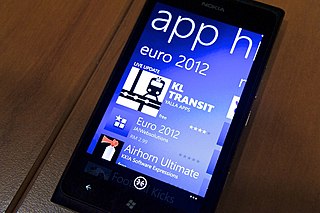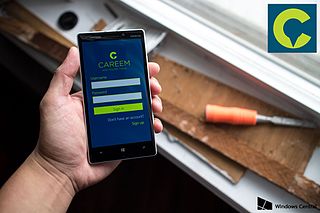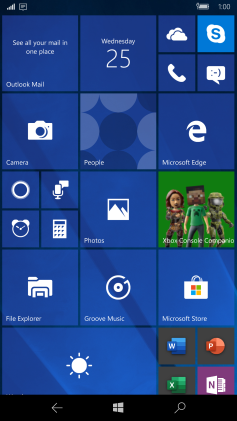
Windows Phone (WP) is a discontinued family of mobile operating systems developed by Microsoft for smartphones as the replacement successor to Windows Mobile and Zune. Windows Phone featured a new user interface derived from the Metro design language. Unlike Windows Mobile, it was primarily aimed at the consumer market rather than the enterprise market.

Nokia Lumia 800 is a smartphone from Nokia, first unveiled on 26 October 2011 at the Nokia World 2011 event. It originally ran on Windows Phone 7.5 "Mango" and was Nokia's first device to run the Windows Phone operating system marking the company's shift from Symbian for their smartphones. It was Nokia's flagship upon the original release in Europe in November 2011, and was thus also a highly important product for Nokia's mobile phone business.

The Nokia Lumia 900 is a Windows Phone-powered smartphone, first unveiled on January 9, 2012, by Nokia at Consumer Electronics Show 2012, where it won the Best Smartphone award in January 2012. The phone has 4G LTE support and was released in April 2012. The Lumia 900 was the flagship smartphone of the Lumia range until the release of its successor, the Lumia 920.

Microsoft Lumia is a discontinued line of mobile devices that was originally designed and marketed by Nokia and later by Microsoft Mobile. Introduced in November 2011, the line was the result of a long-term partnership between Nokia and Microsoft—as such, Lumia smartphones run on Microsoft software, the Windows Phone operating system; and later the newer Windows 10 Mobile. The Lumia name is derived from the partitive plural form of the Finnish word lumi, meaning "snow".

Windows RT is a mobile operating system developed by Microsoft. It is a version of Windows 8 or Windows 8.1 built for the 32-bit ARM architecture (ARMv7). First unveiled in January 2011 at Consumer Electronics Show, the Windows RT 8 operating system was officially launched alongside Windows 8 on October 26, 2012, with the release of three Windows RT-based devices, including Microsoft's original Surface tablet. Unlike Windows 8, Windows RT is only available as preloaded software on devices specifically designed for the operating system by original equipment manufacturers (OEMs).
Microsoft Surface is a series of touchscreen-based personal computers, tablets, and interactive whiteboards designed and developed by Microsoft, most of them running the Windows operating system. They are designed to be premium devices that set examples for manufacturers of other Windows-compatible products. It comprises several generations of hybrid tablets, 2-in-1 detachable notebooks, a convertible desktop all-in-one, an interactive whiteboard, and various accessories, many with unique form factors. The majority of devices in the Surface lineup are based on Intel processors and compatible with Windows 10 or Windows 11.

The Nokia Lumia 820 is a smartphone designed, developed and marketed by Nokia. It is the successor to the Lumia 800 and is one of the first Nokia phones to implement Windows Phone 8 alongside the Nokia Lumia 920. Although sharing a similar appearance with the Lumia 800, the Lumia 820 is a major overhaul over its predecessor, sporting a 4.3 inches (110 mm) diagonal OLED display with scratch resistant glass, though lacking Gorilla Glass protection, 1.5 GHz dual-core processor, and an 8.7-megapixel camera. The phone will come with LTE connectivity and a wireless-charging option. The 820 is the first Nokia Windows Phone OS based smartphone to embed a microSD card slot.
The Nokia Lumia 822 is a smartphone running Windows Phone 8 announced on 29 October 2012. It is exclusively available for Verizon customers. The device is a variant of Nokia Lumia 820. The Lumia 822 supports Qi standard induction charging and LTE connectivity.

The Nokia Lumia 520 is an entry-level Windows Phone 8 smartphone announced by Nokia at the 2013 Mobile World Congress.

The Nokia Lumia 720 is a Windows Phone 8 device manufactured by Nokia. It was announced at the 2013 Mobile World Congress.

Lumia imaging apps are imaging applications by Microsoft Mobile and formerly by Nokia for Lumia devices built on the technology of Scalado. The Lumia imaging applications were notably all branded with "Nokia" in front of their names, but after Microsoft acquired Nokia's devices and services business the Nokia branding was superseded with "Lumia", and often updates included nothing but name changes, but for the Lumia Camera this included a new wide range of feature additions. Most of the imaging applications are developed by the Microsoft Lund division. As part of the release of Windows 10 Mobile and the integration of Lumia imaging features into the Windows Camera and Microsoft Photos applications some of these applications stopped working in October 2015.

The Nokia Lumia 625 is a Windows Phone with a 4.7-inch IPS LCD WVGA (480x800) screen and 4G support. It was presented on July 23, 2013. It can be loaded up with the latest software update for Windows Phone 8.1, as well as Nokia's firmware update 'Denim'. It borrows features from the Nokia Lumia 1520, the Lumia 1020 and the Lumia 925.

Surface 2 is a Surface-series Windows RT hybrid tablet computer created by Microsoft. It was unveiled on September 23, 2013, and released on October 22, 2013 and is the successor to the original Surface. As of January 2015, Microsoft no longer manufactures Surface 2, and provided security updates for the device until January 2023. Microsoft's next attempt at a Windows-on-ARM tablet would be the Surface Pro X, released in 2019, six years after the Surface 2.

The Surface Pro 2 is a Surface-series 2-in-1 detachable produced by Microsoft. Unveiled at an event in New York City on September 23, 2013 and released on October 22, 2013, it succeeds the Surface Pro released in February 2013. While maintaining a design similar to the original design of its predecessor, the Surface Pro 2 has improved hardware specifications compared to it, such as a Haswell Intel Core processor and an increased number of storage options, improved versions of the kickstand and cover accessories.

The Nokia Lumia 1520 was a flagship Windows Phone phablet smartphone designed and produced by Finnish telecommunications manufacturer Nokia in partnership with American software manufacturer Microsoft. The device was first announced at the Nokia World event on 22 October 2013 in Abu Dhabi, alongside its mid-range phablet stablemate the Nokia Lumia 1320 and Nokia's 10.1 inch Windows RT tablet the Nokia Lumia 2520. Until its discontinuation in the United States on 7 April 2015 the phone served as the flagship device for Nokia's Lumia Series and Microsoft's mobile effort. On 6 October 2015 Microsoft officially announced its flagship phablet successor, the Microsoft Lumia 950 XL, with availability sometime in November 2015.

The Nokia Lumia Icon is a high-end smartphone developed by Nokia that runs Microsoft's Windows Phone 8 operating system. It was announced on February 12, 2014, and released on Verizon Wireless in the United States on February 20, 2014. It is currently exclusive to Verizon and the U.S. market; its international counterpart is the Nokia Lumia 930.

The Nokia X family was a range of budget smartphones that was produced and marketed by Microsoft Mobile, originally introduced in February 2014 by Nokia. The smartphones run on the Nokia X platform, a Linux-based operating system which was a fork of Android. Nokia X is also known generally as the Nokia Normandy. It is regarded as Nokia's first Android device during the company's Microsoft partnership and was in the process of selling its mobile phone business to Microsoft, which eventually happened two months later.

Microsoft Mobile was a subsidiary of Microsoft involved in the development and manufacturing of mobile phones. Based in Espoo, Finland, it was established in 2014 following the acquisition of Nokia's Devices and Services division by Microsoft in a deal valued at €5.4 billion, which was completed in April 2014. Nokia's then-CEO, Stephen Elop, joined Microsoft as president of its Devices division following the acquisition, and the acquisition was part of Steve Ballmer's strategy to turn Microsoft into a "devices and services" company. Under a 10-year licensing agreement, Microsoft Mobile held rights to sell feature phones running the S30+ platform under the Nokia brand.

Windows 10 Mobile is a discontinued mobile operating system developed by Microsoft. First released in 2015, it is a successor to Windows Phone 8.1, but was marketed by Microsoft as being an edition of its PC operating system Windows 10.

Microsoft Lumia 950 is a smartphone developed by Microsoft, officially revealed on 6 October 2015 alongside the larger Lumia 950 XL. The phone was first released on AT&T in the United States on 17 November 2015, and subsequently made available on the Microsoft Store as well as in other countries.


















